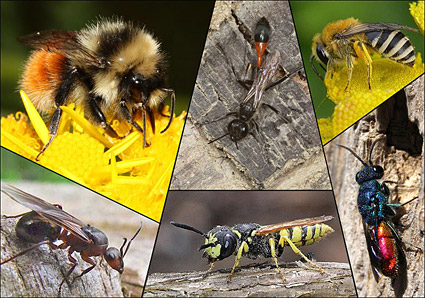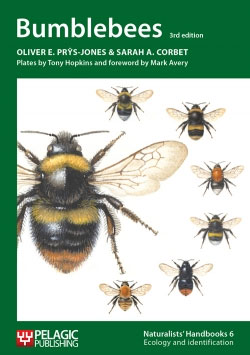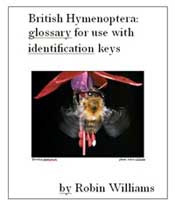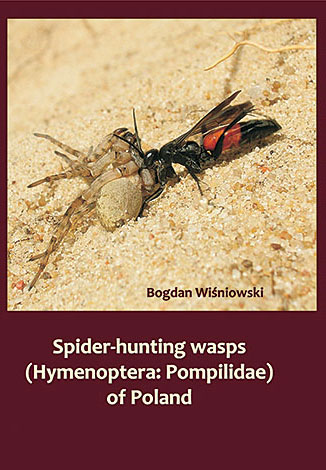First, a caution: Many aculeates require considerable skill and experience in order to determine the correct species. To overcome these difficulties, BWARS runs frequent workshops to help members learn how to identify the various groups of aculeates. Key works that help with the determination of species are listed below.
There are a small number of species that can be determined reasonably easily by beginners, and details of some of these species are given here.
Photographers
For identification advice please use our UK Bees, Wasps and Ants Facebook page where helpful advice from experts is usually quickly available. Once you know the identification then please upload your photo(s) to iRecord along with (who,what, where and when) record data.
Key works for the identification of British Aculeates
Listed here are the key works you can use to help you identify British aculeates. Some texts may be out of print, but are ometimes available as used books.
Bees
Field Guide to Bees of Great Britain and Ireland
BWARS member Steven Falk's much anticipated Field Guide to Bees of Great Britain and Ireland has been published. This is the first extensive guide to all the British and Irish bee species since Edward Saunder's 1896 tome - The Hymenoptera Aculeata of the British Islands. The new field guide is 432 pages, with keys, species accounts and many photographs of nearly every species. In addition there are many illustrations by renowned insect illustrator Richard Lewington.
Updates and corrections for the book are being listed on Steven Falk's photostream here
Baldock, D.W., (2008) Bees of Surrey. Surrey Wildlife Trust.
Although not primarily an identification guide, BWARS member, David Baldock's book contains a very helpful key (by another BWARS member Graham A Collins) to the genera of bees found in Britain. In addition, the species accounts often include helpful pointers on identifying individual species.
Else, G. (1999). Identification - Leafcutter Bees. British Wildlife, Vol 10, Number 6. pp 388 - 393. Contains a key to all eight species of British Megachile.
Rowson R. & Pavett, M. (2008). A visual guide for the identification of British Coelioxys bees
BWARS members Rhian Rowson and Mark Pavett have made this easy to use guide to the Coelioxys cuckoo-bees available for download here.
Pesenko, Y. A., Banaszak, J., Radchenko, V. G. & Cierzniak, T. (2000) Bees of the Family Halictidae (excluding Sphecodes) of Poland. Wydawnictwo Uczelniane Wyższej Szkoły Pedagogicznej w Bydgoszczy. A useful book that covers all the British species of the genera Halictus & Lasioglossum. Text in English. The keys in this book need to be treated with some caution.
For those who can read French or German the following four well illustrated volumes are highly recommended:
Amiet, F., Herrmann, M., Müller, A. & Neumeyer, R. (2001) Apidae 3: Halictus, Lasioglossum. Fauna Helvetica 6. CSCF/SEG.
Amiet, F., Herrmann, M., Müller, A. & Neumeyer, R. (2004) Apidae 4: Anthidium, Chelostoma, Coelioxys, Dioxys, Heriades, Lithurgus, Megachile, Osmia, Stelis. Fauna Helvetica 9. CSCF/SEG.
Amiet, F., Herrmann, M., Müller A. & Neumeyer, R. (2011) Apidae 5: Ammobates, Ammobatoides, Anthophora, Biastes, Ceratina, Dasypoda, Epeoloides, Epeolus, Eucera, Macropis, Melecta, Melitta, Nomada, Pasites, Tetralonia, Thyreus, Xylocopa. Fauna Helvetica 20. CSCF/SEG.
Amiet, F., Herrmann, M., Müller, A. & Neumeyer, R. (2011) Apidae 6: Andrena, Melitturga, Panurginus, Panurgus. Fauna Helvetica 26. CSCF/SEG.
Wasps
Perkins, J. F. (1976). Hymenoptera Bethyloidea (excl. Chrysididae) Handbooks for the Identification of British Insects, 6 part 3a. Royal Entomological Society.
Morgan, D. (1984). Cuckoo-Wasps: Hymenoptera, Chrysididae. Handbooks for the Identification of British Insects 6 part 5. Royal Entomological Society. A useful text, particularly when reinforced by Mike Archer's additional notes - download from Resources page
Juho Paukkunen, Alexander Berg, Villu Soon, Frode Ødegaard, Paolo Rosa (2015) An illustrated key to the cuckoo wasps (Hymenoptera, Chrysididae) of the Nordic and Baltic countries, with description of a new species contains extremely helpful, good quality photographs of key features. This paper can be downloaded here
British species of the Chrysis ignita group: A workshop presentation given by Juho Paukkunen at the BWARS Members' Weekend 2019, outlines key characters for separating the 13 British species of the cryptic Chrysis ignita group. Juho cautioned that colour characters given in the Nordic and Baltic Chrysididae key (Paukkunen et al., 2015) are not reliable for British specimens. Download the presentation here
Day, M. C. (1988). Spider Wasps - Hymenoptera: Pompilidae. Handbooks for the Identification of British Insects 6 part 4. Royal Entomological Society.
Wiśniowski, B. (2009) Spider-hunting Wasps of Poland. Ojców National Park. Covers all the British Pompilidae except one species (Aporus unicolor). An excellent full colour key with plenty of photographs of key features is included. Unfortunately this book is now out of print and difficult to find as a used item.
Richards O. W, (1980). Scolioidea, Vespoidea and Sphecidae. Handbooks for the Identification of British Insects 6 part 3(b). Royal Entomological Society. Some nomenclature has changed since publication, but still an important key for British aculeate wasps.
Archer, M. A. (2014). The Vespoid Wasps (Tiphiidae, Mutillidae, Sapygidae, Scoliidae and Vespidae) of the British Isles. Handbooks for the Identification of British Insects, Volume 6, Part 6. Royal Entomological Society. Has well illustrated keys and detailed species accounts. There are colour images of many species.
Archer, M. A. (2003). The British Potter and Mason Wasps - A Handbook. BWARS. A detailed handbook, providing keys, distribution maps and profiles of all the British Eumeninae. The key from this work is available to download here
Yeo, P. F. & Corbet, S. A. (1995). Solitary Wasps. Naturalists Handbooks 3. Richmond Publishing Co. Ltd. An excellent guide, with keys to most British aculeate wasps and colour plates illustrating a representative selection of the British species.
Bitsch J. et al. (1993, 1997, 2001 and forthcoming). Hyménoptères Sphecidae d'Europe Occidentale Volumes 1-4. Faune de France. FFSSN. Text in French, but highly recommended volumes covering sphecid and crabronid wasps.
Olmi, M (1994). The Dryinidae and Embolemidae (Hymenoptera: Chrysidoidea) of Fennoscandia and Denmark. Fauna Entomologica Scandinavica 30. Brill. A useful text for these very difficult families.
Else, G. R., (1994) Social Wasps British Wildlife, Volume 5, pp 304-311.
Reference for Psenulus pallipes/Psenulus chevrieri :Christian Schmid-Egger, The Psenulus pallipes species group in Central Europe (Hymenoptera, Crabrionidae) Ampulex 8 40-44 http://www.ampulex.de/ampu8.pdf
Reference for Passaloecus gracilis/ turionum: K. M. Guichard, 2002 Passaloecus turionum Dahlbom, 1845 (Hymenoptera Sphecidae) new to the British List. Ent. Gazette 53:1, 33-36
Ants
Skinner, G. J. & Jarman, A. P. (2025). Ants. Naturalists Handbooks 24 2nd Edition. Pelagic Publishing.
Contains up-to-date keys to help identify almost all species of ant found in Britain. This is a new edition to that published in 1996.
Bolton, B. & Collingwood, C. A. (1975). Hymenoptera, Formicidae. Handbooks for the Identification of British Insects 6 part 3c, Royal Entomological Society.
Somewhat technical and a little out of date with some species missing. Out of print but a pdf version can be found here.
Czechowski, W., Radchenko, A. & Czechowska, W. (2002), The Ants (Hymenoptera, Formicidae) of Poland. MIZ.
A useful guide in English, with most British species covered, but the keys to male Lasius are omitted!
Seifert, B. 2018. The Ants of Central and North Europe Tauer, Germany. In English with excellent keys, drawings and photographs. An updated version of the 2007 Die Ameisen Mittel- und Nordeuropas.
Collingwood, C. A. (1979). The Formicidae (Hymenoptera) of Fennoscandia and Denmark. Fauna Entomologica Scandinavica 8: 1-174.
In English. Easy to use keys and drawings. A little out of date with some species not covered. Out of print but a pdf version can be found here.

Clock-wise from top left: Bombus monticola - Nick Owens;
Ammophila sabulosa - Bernhard Jacobi; Colletes daviesanus
- Jelle Devalez; Chrysis ignita/impressa - Nigel Jones;
Philanthus triangulum - Keith Balmer; Formica rufa - Neil Robinson
Bumblebees
Bumblebees are a well covered group, with several useful guides available. With the wide availability of identification guides, bumblebees are a popular group for beginners to start with.
Edwards, M. & Jenner, M. (2009). Field Guide to the Bumblebees of Great Britain & Ireland. Ocelli Ltd.
This is an excellent guide that is easy to use and to carry in the field. It contains a quick colour pattern key to UK species, plus colour photos of all the UK species. 
Prys-Jones, O. E. and Corbet, S. A. (2011 - revised edition). Bumblebees. Pelagic Publishing.
Another small and easy to carry book. Perhaps not as easy to use in the field as Edwards and Jenner's book, but still a very useful guide. Contains full, illustrated keys.
Benton, T. (2006) Bumblebees, Collins New Naturalist Library: 98, Harper Collins. Contains an excellent key to, and descriptions, of British bumblebees.
Warwickshire's Bumblebees by Steven Falk (2011), available as free download from this website, contains many excellent photographs and identification tips for most British bumblebees.
Steven Falk has also made an extremely helpful Bombus section on his Flickr pages. This includes many images and helpful field identification hints for 23 of the 24 UK species.
There is a useful online identification guide - Paul Williams's web site at British Bumblebees
General
Glossary: One of the toughest challenges often faced by hymenopterists is understanding the immense variety of terminology used to describe the characteristics of hymenoptera. Fortunately, BWARS member Robin Williams has produced an excellent publication that covers most of the terminology:
British Hymenoptera : glossary for use with identification keys. 
Robin Williams, Kyntons Mead, Heath House, Wedmore, Somerset, BS28 4UQ
Price: £14 including post and packaging (UK).
Wilmer, P. (1985). Bees, Ants and Wasps - A Key to the Genera of the British Aculeates. Field Studies Council. An Aidgap tested key.
A useful key to genera of British aculeates.

Other resources
Test keys and other identification resources are available as free downloads on the Identification guides page.

